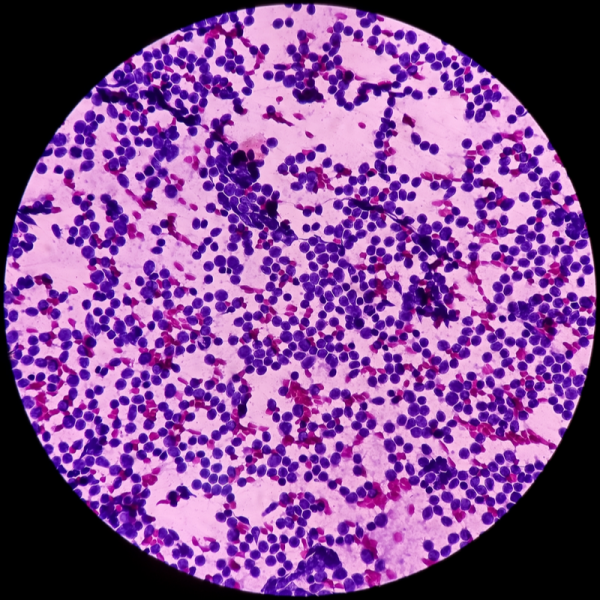
What is B-cell lymphoma?
B-cell lymphoma is a malignant disease that affects the lymphatic system and belongs to the super-group of non-Hodgkin's lymphomas. The lymphatic system is responsible for the specific defence against pathogens and consists of lymphocytes, the so-called white blood cells. In B-cell lymphoma, the B-lymphocytes can contribute to the development of various lymphomas, which are grouped together under the disease of B-cell lymphoma. Because B-cell lymphoma develops quickly and scatters lymphoma cells in the body at an early stage, it is one of the aggressive lymphomas that occur slightly more often in men than in women.
What causes B-cell lymphoma to develop?
B-cell lymphoma can form due to the faulty cell division of a single B-cell, unless this fault is repaired immediately. Although most errors in cell division result in the daughter cell not surviving, there are also errors that give the daughter cell an advantage. The latter then contributes to uncontrolled cell growth in the B lymphocyte in which the error first occurred.
What forms of B-cell lymphomas are distinguished?
B-cell lymphomas are generally distinguished between the following indolent (low-malignant) and the aggressive (high-malignant) forms:
- indolent B-cell lymphomas:
- chronic lymphocytic leukaemia (CLL),
- Extranodal MALT lymphoma,
- Follicular lymphoma,
- Hairy cell leukaemia,
- Mantle cell lymphoma,
- Marginal zone lymphoma,
- Multiple myeloma,
- Lymphoplasmacytic lymphoma,
- aggressive B-cell lymphoma:
- analplastic, immunoblastic or lymphoblastic lymphomas,
- Burkitt's lymphoma,
- Diffuse large B-cell lymphoma (DLBCL)
What are the symptoms of B-cell lymphoma?
A B-cell lymphoma can make itself felt by a lymph node that is getting bigger or by a swelling of the lymph nodes. The lymph nodes in the neck area or in the chest area (the so-called mediastinum) are affected much more often than the lymph nodes that are located below the diaphragm. However, both enlarged lymph nodes and lymph node swelling can be caused by other medical conditions. Because they are usually not sensitive to pressure and only become painful when they grow extremely quickly, B-cell lymphoma is usually diagnosed late.
If the B-cell lymphoma has already spread to the bone marrow, this can lead to an inhibition of normal blood formation. This happens in about 10 per cent of all first diagnoses. Patients then complain of fatigue or general listlessness due to a drop in red blood cells (a so-called anaemia). If the number of platelets is also reduced (thrombocytopenia), this can increase the risk of bleeding, while the lack of white blood cells (leukocytopenia) leads to an increased risk of infection. In addition, there may be unwanted weight loss, regularly recurring episodes of fever and night sweats.
How is B-cell lymphoma diagnosed?
After taking the medical history, the doctor will perform a physical examination, which focuses mainly on listening, palpation, but also tapping, in order to detect a possible B-cell lymphoma. This is followed by a blood test and a computer tomography (CT) of the neck, chest, abdomen and pelvis. The CT can be combined with a so-called positron emission tomography (=PET). In this examination, the patient is injected with radioactively labelled sugar. This accumulates in the metabolically active tissues and can then be imaged with a camera.
The B-cell lymphoma can already be detected by the results of a blood test, provided that the cells have already settled and multiplied in the bone marrow. In this case, they displace the normal blood formation and contribute to an altered blood picture. In a large blood count, it can be determined exactly which forms of leukocytes are reduced. If there is an enlarged lymph node and it is not in an unfavourable location, the doctor can also take a tissue sample from it. A qualified haematopathologist, who specialises in the diagnosis of malignant diseases of the immune and blood systems, can make statements about the type of lymphoma by means of immunological examinations.
How is B-cell lymphoma treated?
Since B-cell lymphoma is an aggressive, fast-growing lymphoma, it should be treated immediately after diagnosis. Treatment should be carried out by experienced specialists in haematology and oncology. B-cell lymphoma is usually primarily treated with immunochemotherapy, a so-called R-CHOP. Here, antibodies (monoclonal antibodies) produced in the laboratory from a cell line are combined with one or more chemotherapeutic drugs (cytostatics). The antibodies produced in the laboratory (anti-CD20 antibodies) are described with the R in the name of the R-CHOP therapy (rituximab), while CHOP stands for chemotherapy. Each letter stands for a drug:
- C: cyclophosphamide
- H: Doxorubicin
- O: vincristine
- P: Prednisone
As a rule, R-CHOP therapy is carried out at intervals of two or three weeks with an average of six courses.
What is the prognosis for B-cell lymphoma?
The treatment of B-cell lymphoma has improved steadily in recent years, so that a cure rate of 80 percent has now been achieved. However, the prerequisite for this is that the treatment is carried out as prescribed by the doctor in the planned dose and without delays. Whether a B-cell lymphoma develops again (recurrence) after successful treatment depends on both the age and the general health of the patient.
Become a member now
As a member, you will receive further information and frequencies on this topic! Log in here!
